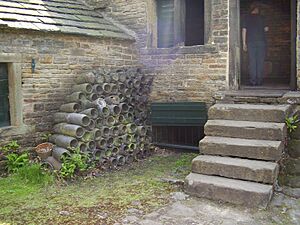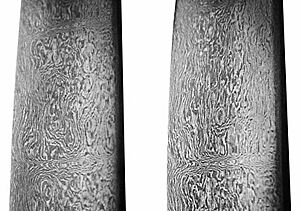Crucible steel facts for kids
Crucible steel is a special type of steel made by melting different kinds of iron in a sealed container called a crucible. People would melt pig iron (which has lots of carbon), regular iron, and sometimes even other steel. They often added things like sand, glass, or ashes to help clean the metal.
This amazing steel was first made in Southern India and Sri Lanka around 2,500 years ago. Back then, it was hard to make fires hot enough to melt iron. But pig iron melts at lower temperatures. By soaking wrought iron (which has very little carbon) in melted pig iron for a long time, the carbon from the pig iron slowly spread into the wrought iron. This turned both into a strong steel.
This ancient method often created a very hard steel with a cool, wavy pattern. You might have seen this pattern on famous Damascus swords. This steel was usually very high in carbon (about 1.5% to 2.0%) and very pure. It was often shaped with light hammering at low temperatures to keep its special qualities.
Later, in the 1700s, a man named Benjamin Huntsman developed crucible steel in England. He used coke as fuel, which made fires hot enough to melt steel completely. Huntsman's method melted the steel for a longer time and cooled it slowly. This allowed the carbon to mix perfectly throughout the liquid steel, making it very uniform. This was a huge step forward! It meant steel could be poured into molds, and impurities could float to the top and be removed. Huntsman's process created the first truly modern quality steel. It helped kick off the Industrial Revolution by making lots of high-quality steel for tools, knives, and machines.
Contents
How Crucible Steel Was Made
Steel is an alloy of iron and carbon. The amount of carbon changes how strong or flexible the steel is.
- Cast iron has a lot of carbon (2–4%).
- Wrought iron has very little carbon (less than 0.1%).
- Steel has a medium amount of carbon, making it strong but not too brittle.
Crucible steel was made by putting the raw materials into a crucible, which kept them separate from the heat source. This allowed for careful control of the carbon content. People could add things like limestone to the crucible to remove unwanted stuff like sulfur.
Different ways were used to make crucible steel:
- Adding carbon to iron: This was the most common method. Wrought iron was heated with charcoal in crucibles. The carbon from the charcoal slowly moved into the iron, turning it into steel. This is how wootz steel was made in India.
- Removing carbon from cast iron: This method involved taking carbon out of cast iron.
- Mixing wrought iron and cast iron: In this method, wrought iron and cast iron were heated together in a crucible until they melted and mixed, forming steel. This was used in places like Persia and Central Asia.
Ancient texts from the Islamic world, like those by al-Biruni, describe these methods. They even mention using things like pomegranate rinds, fruit peels, and egg whites as sources of carbon!
Ancient History of Crucible Steel
Crucible steel is thought to have started in India and Sri Lanka with the "wootz" process. It then spread to other places through trade. Recently, archaeologists found that places like Merv in Turkmenistan and Akhsiket in Uzbekistan were also big centers for making crucible steel between the 8th and 12th centuries CE. Indian steel was famous for its ability to stay sharp, partly because its iron ore had special elements like vanadium.
Even though crucible steel is often linked to the Middle East, some very old pattern welded swords found in Europe (from the 3rd century CE) likely used high-carbon crucible steel. Swords with the brand name Ulfberht, made between the 9th and 11th centuries, are great examples. Many think the way these blades were made came from the Middle East through trade routes.
In the early Islamic period, scientists like Jabir ibn Hayyan and al-Kindi studied swords and steel. Their writings contain much more information about Indian and Damascus steels than any surviving texts from ancient Greece or Rome.
India and Sri Lanka
Many stories describe how Indian crucible steel was made. Scientists have studied the remains of steel production in four areas: three in India and one in Sri Lanka. Indian and Sri Lankan crucible steel is often called wootz, which is a changed English word from "ukko" or "hookoo" in Indian languages.
European travelers from the 1600s onwards wrote about the famous "wootz" steel made in southern India. The main center for making crucible steel in the 1600s seemed to be in Hyderabad. The process there involved melting two different kinds of iron together: one with low carbon and one with high carbon. Wootz steel was traded widely across ancient Europe, China, and the Arab world. It became especially famous in the Middle East as Damascus steel.
Recent digs show that Sri Lanka also had advanced ways of making iron and steel long ago. Their method was a bit like adding carbon to wrought iron. The oldest confirmed crucible steel site in Sri Lanka is in the Knuckles Mountain Range, dating from the 6th to 10th centuries CE.
Archaeologists also found unique "west-facing" furnaces in Sri Lanka. These furnaces were built on the western sides of hills to use the wind for smelting iron directly into steel. These furnaces were used between the 7th and 11th centuries.
Central Asia
Central Asia has a long history of making crucible steel, starting around the late 900s CE. In modern Uzbekistan and Turkmenistan, there is strong proof of large-scale crucible steel production. These sites date from the late 8th to late 12th centuries CE.
Two important sites in eastern Uzbekistan are Akhsiket and Pap in the Ferghana Valley, located along the Great Silk Road. Archaeologists found hundreds of thousands of crucible fragments there, showing that iron was heated to add carbon and make steel. This method is called the Ferghana Process and lasted for about 400 years.
Evidence of crucible steel production was also found in Merv, Turkmenistan, another major city on the Silk Road. The scholar al-Kindi mentioned that the Khorasan region (which included Merv) was a steel-making center in the 800s CE. At Merv, a workshop from the 800s–900s CE showed a method of melting different metals together to make steel.
China
China started making crucible steel around the 1st century BC, or even earlier. The Chinese had already figured out how to make pig iron around 1200 BC. By the 1st century BC, they developed ways to make mild steel and to quickly remove carbon from melted cast iron to make wrought iron. Around this time, they began making crucible steel to turn extra cast iron and wrought iron into steel for swords and weapons.
In 1064, a Chinese scholar named Shen Kuo wrote about the patterns in steel and how swords were made. He explained that ancient people used "combined steel" for the sharp edge and "soft iron" for the back of the sword. This kept the sword from breaking. He also described patterns that looked like "snake-coiling" or "pine tree design."
Modern History of Crucible Steel
The first mentions of crucible steel in Europe appeared after the Middle Ages. Europeans tried to make "Damascus steel" from the 1500s onwards. But it wasn't until the 1790s that scientists started studying Indian "wootz" steels. Travelers had brought back reports of how this steel was made in southern India.
Many European travelers wrote about seeing steel being made in India from the mid-1600s. Famous scientists like Michael Faraday were very interested in wootz steel. George Pearson's report in 1795 really sparked interest among European scientists. He was the first to publish his findings and use the word "wootz" in print.
Another researcher, David Mushet, figured out that wootz was made by melting. He patented his own process in 1800. However, the first successful European method had already been developed by Benjamin Huntsman about 50 years earlier.
Making Steel in England

Benjamin Huntsman was a clockmaker who wanted better steel for clock springs. In Handsworth, near Sheffield, England, he started making steel in 1740 after years of secret experiments. Huntsman's system used a furnace heated by coke, which could reach very high temperatures. Inside, he placed up to twelve clay crucibles, each holding about 15 kg of iron.
When the crucibles were super hot, they were filled with lumps of blister steel (iron with carbon) and a special mix to remove impurities. After about 3 hours, the crucibles were removed. Any impurities floating on top were skimmed off, and the melted steel was poured into molds to make solid blocks called ingots. Melting the steel completely made it very uniform when it cooled. This gave the metal much greater strength and hardness than other steels made at the time.
Before Huntsman's method, Sheffield made about 200 tons of steel per year. Huntsman's technique changed everything! One hundred years later, Sheffield was making over 80,000 tons per year, almost half of Europe's total. Sheffield grew from a small town into a major industrial city.
The steel was made in special workshops called 'crucible furnaces'. These buildings had melting holes, vents, and shelves for the crucibles. There were also rooms for weighing materials and making the clay crucibles. The steel, first used for clock springs, soon found its way into scissors, axes, and swords.
Sheffield's Abbeydale Industrial Hamlet still shows how scythes were made using crucible steel from Huntsman's time.
Qualities of the Steel
Before Huntsman, steel was often made by a method that created layers of high-carbon steel and lower-carbon iron. To make it more even, the steel was hammered flat, stacked, and welded together. But the more it was heated and worked, the more carbon it lost. This meant the steel wasn't good enough for things like springs, knives, or tools.
Huntsman's process was the first to make steel completely uniform. By fully melting the steel, the carbon could spread evenly throughout the liquid. The added materials also helped remove most impurities, creating the first steel of modern quality. Since no oxygen was blown through the steel, it was even better than steel made by the later Bessemer process. Huntsman's method was used for making tool steel until electric furnaces came along in the early 1900s.
This high-quality steel was quickly used for making tools, machine parts, cutlery, and many other items. It also allowed other elements to be mixed with the steel. Huntsman was one of the first to add things like manganese to help remove oxygen from the steel. His process led to the creation of the first alloy steels, like stainless steel.
Later Production
In the United States in the 1880s, another method was developed where iron and carbon were melted together directly to make crucible steel. Throughout the 1800s and early 1900s, a lot of crucible steel was used to make cutting tools, where it was called tool steel.
Today, the crucible process is no longer used for most steel. Similar high-quality steels are now made using an electric arc furnace. Some uses for tool steel have also been replaced by newer materials like tungsten carbide.
Crucible Steel Elsewhere
Another type of crucible steel was developed in 1837 by Russian engineer Pavel Petrovich Anosov. His method focused more on quickly cooling the melted steel when the right crystal structure formed. He called his steel bulat, but his secret method was lost when he died. In the United States, William Metcalf was a pioneer in crucible steel.
See also
- Damascus steel
- Noric steel
- Pattern welding



